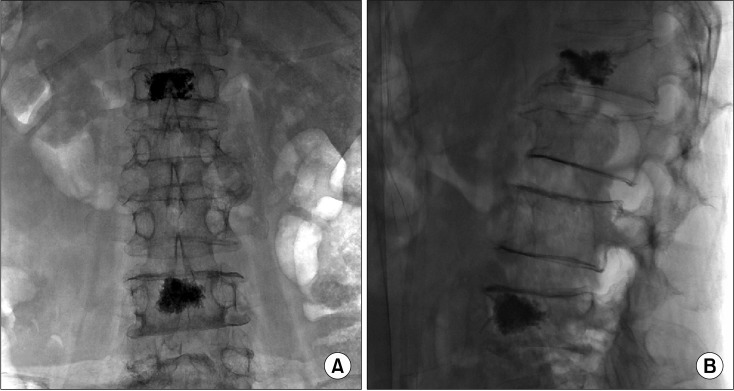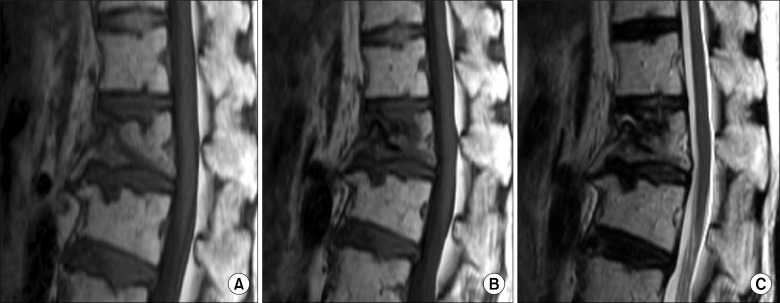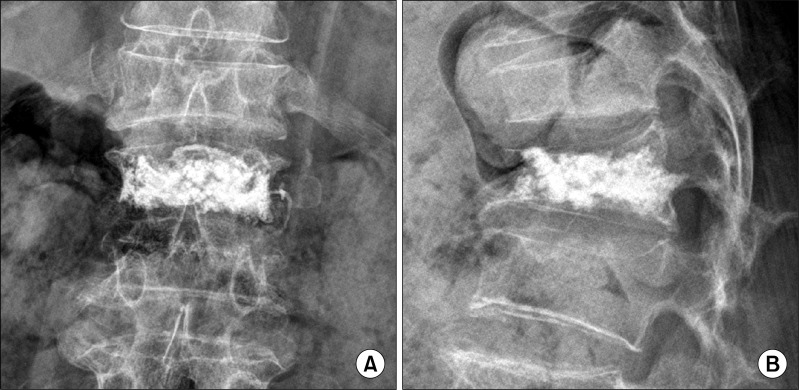Korean J Pain.
2013 Jan;26(1):94-97. 10.3344/kjp.2013.26.1.94.
Repeat Vertebroplasty for the Subsequent Refracture of Procedured Vertebra
- Affiliations
-
- 1Department of Anesthesiology and Pain Medicine, Korea University Guro Hospital, Seoul, Korea. clonidine@empal.com
- KMID: 1779033
- DOI: http://doi.org/10.3344/kjp.2013.26.1.94
Abstract
- Vertebroplasty (VP) can effectively treat pain and immobility caused by vertebral compression fracture. Because of complications such as extravasation of bone cement (polymethylmethacrylate, PMMA) and adjacent vertebral fractures, some practitioners prefer to inject a small volume of PMMA. In that case, however, insufficient augmentation or a subsequent refracture of the treated vertebrae can occur. A 65-year-old woman visited our clinic complaining of unrelieved severe low back and bilateral flank pain even after she had undergone VP on the 1st and 4th (L1 and L4) lumbar vertebrae a month earlier. Radiologic findings showed the refracture of L1. We successfully performed the repeat VP by filling the vertebra with a sufficient volume of PMMA, and no complications occurred. The patient's pain and immobility resolved completely three days after the procedure and she remained symptom-free a month later. In conclusion, VP with small volume cement impaction may fail to relieve fracture-induced symptoms, and the refracture of an augmented vertebral body may occur. In this case, repeat VP can effectively resolve both the persistent symptoms and problems of new onset resulting from refracture of the augmented vertebral body due to insufficient volume of bone cement.
MeSH Terms
Figure
Reference
-
1. Silverman SL. The clinical consequences of vertebral compression fracture. Bone. 1992; 13(Suppl 2):S27–S31. PMID: 1627411.
Article2. Cortet B, Cotten A, Boutry N, Flipo RM, Duquesnoy B, Chastanet P, et al. Percutaneous vertebroplasty in the treatment of osteoporotic vertebral compression fractures: an open prospective study. J Rheumatol. 1999; 26:2222–2228. PMID: 10529144.3. Barr JD, Barr MS, Lemley TJ, McCann RM. Percutaneous vertebroplasty for pain relief and spinal stabilization. Spine (Phila Pa 1976). 2000; 25:923–928. PMID: 10767803.
Article4. Choi Y, Han HC, Lim KJ. Pulmonary embolism after percutaneous vertebroplasty with polymethylmethacrylate: a case report. J Korean Pain Soc. 2002; 15:190–193.5. Kim DH, Kim KH, Kim YC. Minimally invasive percutaneous spinal techniques. 2011. Pennsylvania: Elsevier;p. 259–276.6. Lin WC, Lee YC, Lee CH, Kuo YL, Cheng YF, Lui CC, et al. Refractures in cemented vertebrae after percutaneous vertebroplasty: a retrospective analysis. Eur Spine J. 2008; 17:592–599. PMID: 18204942.
Article7. Lin CC, Shen WC, Lo YC, Liu YJ, Yu TC, Chen IH, et al. Recurrent pain after percutaneous vertebroplasty. AJR Am J Roentgenol. 2010; 194:1323–1329. PMID: 20410421.
Article8. Belkoff SM, Mathis JM, Jasper LE, Deramond H. The biomechanics of vertebroplasty. The effect of cement volume on mechanical behavior. Spine (Phila Pa 1976). 2001; 26:1537–1541. PMID: 11462082.9. Luo J, Daines L, Charalambous A, Adams MA, Annesley-Williams DJ, Dolan P. Vertebroplasty: only small cement volumes are required to normalize stress distributions on the vertebral bodies. Spine (Phila Pa 1976). 2009; 34:2865–2873. PMID: 20010394.10. Kaufmann TJ, Trout AT, Kallmes DF. The effects of cement volume on clinical outcomes of percutaneous vertebroplasty. AJNR Am J Neuroradiol. 2006; 27:1933–1937. PMID: 17032870.11. Al-Ali F, Barrow T, Luke K. Vertebroplasty: what is important and what is not. AJNR Am J Neuroradiol. 2009; 30:1835–1839. PMID: 19713320.
Article12. Han IH, Chin DK, Kuh SU, Kim KS, Jin BH, Yoon YS, et al. Magnetic resonance imaging findings of subsequent fractures after vertebroplasty. Neurosurgery. 2009; 64:740–744. PMID: 19349832.
Article
- Full Text Links
- Actions
-
Cited
- CITED
-
- Close
- Share
- Similar articles
-
- Predictive Risk Factors for Refracture after Percutaneous Vertebroplasty
- Percutaneous Vertebroplasty in Osteoporotic Vertebral Compression Fractures; The Degree of Vertebral Compression and Outcome
- Risk Factors of New Compression Fractures in Adjacent Vertebrae after Percutaneous Vertebroplasty
- Risk Factors for Subsequent Fracture after Osteoporotic Vertebral Compression Fracture
- Percutaneous Vertebroplasty: A New Serial Injection Technique to Minimize Cement Leak




